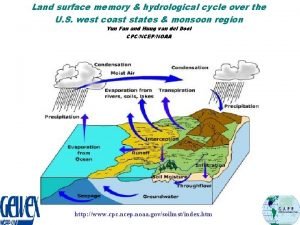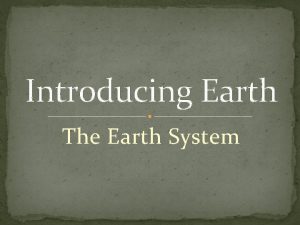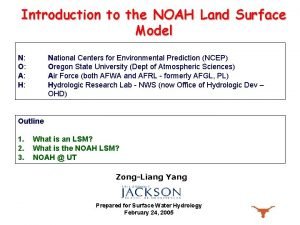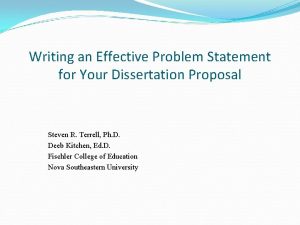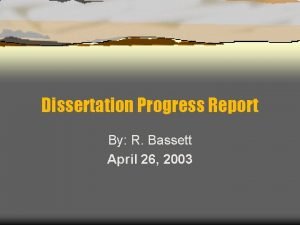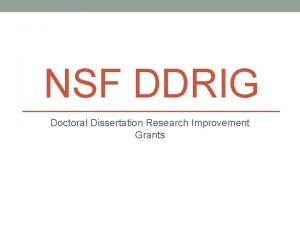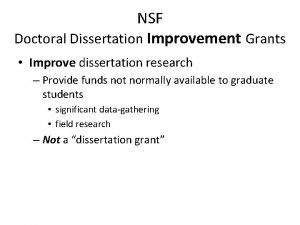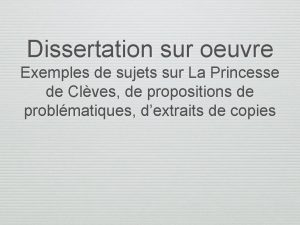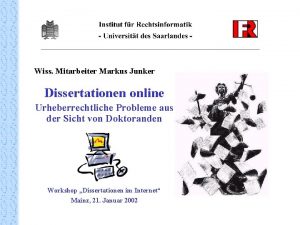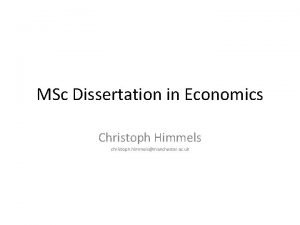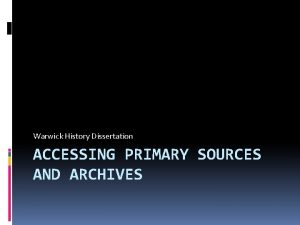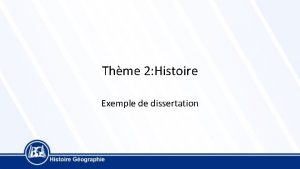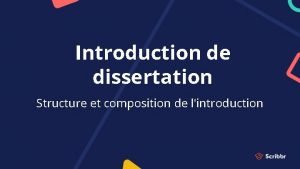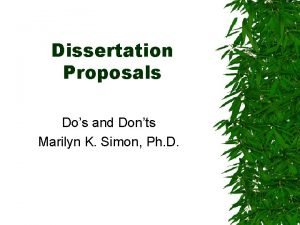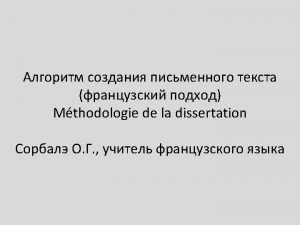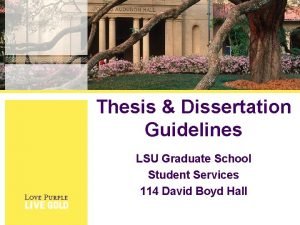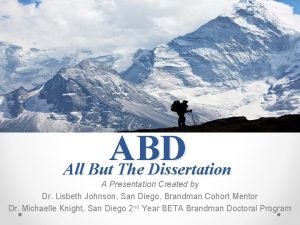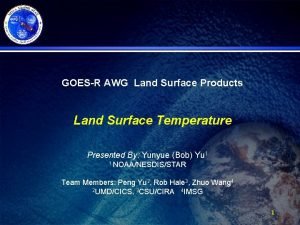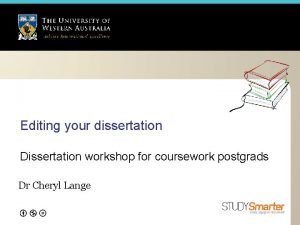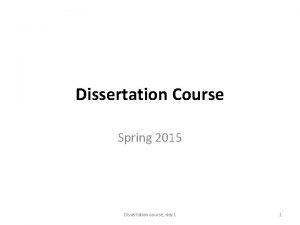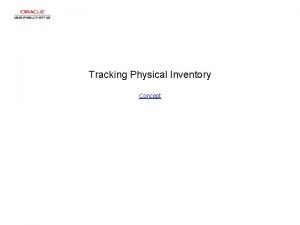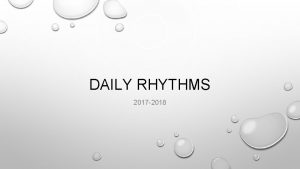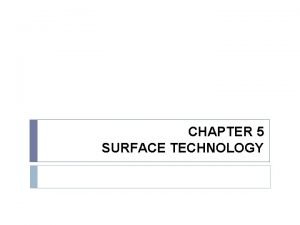Ph D Dissertation Defense Tracking Daily Land Surface


















































- Slides: 50

Ph. D Dissertation Defense Tracking Daily Land Surface Albedo and Reflectance Anisotropy with MODerate-resolution Imaging Spectroradiometer (MODIS) Yanmin Shuai Department of Geography and Environment, Boston University Dissertation Committee Crystal B. Schaaf Alan H. Strahler Curtis E. Woodcock Xiaowen Li Qijiang Zhu David Roy Xiaoyang Zhang

1. Introduction Contents 1. Background 2. Research Interest 3. Research Topics • Quantify uncertainty in MODIS BRDF/Albedo Retrievals • Daily Land Surface Reflectance Anisotropy and Albedo from MODIS • Daily Vegetation Monitoring with the MODIS Reflectance Anisotropy and Albedo Products 4. Concluding Remarks Yanmin Shuai - MODIS BRDF/Albedo 2

Background: Reflectance anisotropy • Describe the intrinsic reflective properties of land surface. • Characterized by the Bidirectional Reflectance Distribution Function (BRDF) Isotropic reflectance Directional reflectance Backscattering Forward scattering region vs. Forward Scattering Backscattering (hot-spot) region The forward and backscattering regions have been recognized as structural identifiers of vegetation canopies; e. g. the amplitude of the hot-spot region shows a good agreement with the expected values for the leaf reflectance. © 1992 - 2009 Jennifer Vranes http: //www. jensart. com/ Photograph by Don Deering.

BRDF Example BRDF rendering of a forest canopy composed of opaque cone and cylindrical objects viewed from three directions: (a) backward scattering (sun behind observer), where the sun and the viewer are on the same side, hiding most of the shadows; (b) nadir view, where a maximum of the background can be seen; (c) forward scattering (sun opposite observer) where the sun and the viewer are on the opposite side. A B C Yanmin Shuai - MODIS BRDF/Albedo http: //www. ccrs. nrcan. gc. ca/optic/coarse/beps/scale_e. php 4

BRDF Applications • Deriving various reflectance quantities, such as albedo (Lucht et al. , 2000; Strahler et al. , 1995) • Characterize the surface energy budget (Dickinson 1983, 1990) • Correction of view and illumination angle effects (Roy et al. , 2002, Schaaf et al. , 2002) • • Land cover classification (Friedl et al. , 2002) Vegetation Phenology (Zhang 2003, 2006…) Cloud detection (Roy et al. , 2006) Atmospheric correction (Hu et al. , 1999) Yanmin Shuai - MODIS BRDF/Albedo 5

Current algorithm • Forward model: kernel based BRDF model(RTLS-R) -Roujean et al. , 1992 Isotropic kernel • • Volumetric kernel Geometric kernel (surface scattering) The operational MODIS BRDF/albedo algorithm uses high-quality, multi-day, cloud free atmospherically-corrected surface reflectances to provide global 500 m reflectance quantities every 8 day. The retrieval quality is assessed by two measures: Wo. D and RMSE. Yanmin Shuai - MODIS BRDF/Albedo 6

Temporal BRDF change • Temporal BRDF shapes for 4 typical biomes Selected biomes: • Deciduous broadleaf forest (DBF) • Evergreen broadleaf forest (EBF) • Irrigate cropland • Sandy area Yanmin Shuai - MODIS BRDF/Albedo 7

Research Interests • Optimize MODIS BRDF/Albedo Products for Regional users • Specify algorithm retrieval characteristics for various biomes • Develop a daily algorithm for Direct Broadcast users • Apply daily algorithm to track fine scale phenology Yanmin Shuai - MODIS BRDF/Albedo 8

Research Topics - I. Quantify Uncertainty in MODIS BRDF/Albedo Retrieval System Shuai Y. , C. B. Schaaf, A. H. Strahler, J. Liu, and Z. Jiao (2008), Quality assessment of BRDF/albedo retrievals in MODIS operational system, Geophys. Res. Lett. , 35, L 05407, doi: 10. 1029/2007 GL 032568. Yanmin Shuai - MODIS BRDF/Albedo 9

Part I. Motivation • Investigate the quality of model-fit and angular sampling in the BRDF inversion • Evaluate the two quality measures: RMSE (Root Mean Squared Error) and Wo. D (Weight of Determination) • Determine biome-appropriate thresholds for the MODIS 500 m BRDF/albedo operational system Yanmin Shuai - MODIS BRDF/Albedo 10

• Forward model: kernel based BRDF model(RTLS-R) Isotropic kernel Volumetric kernel Geometric kernel (surface scattering) • Inversion with given n reflectance observations by a least-squares method , where The Inverse Matrix i. e. -1 M Reference: Strahler et. al , 1999; Lucht et. al, 2000 b Yanmin Shuai - MODIS BRDF/Albedo 11

Part I. Wo. D (Weight of Determination) Where U is a vector composed of the weighting of the kernels • For Wo. D_f 0, UT=(1, 0, 0) • For Wo. D_WDR at given sun-view geometry (45°, 0°), • For Wo. D_BSA , • For Wo. D_WSA, UT= • Wo. D describe the behavior of the kernel-driven linear models under conditions of limited and varying angular sampling. • We use both Wo. D-WDR and Wo. D-WSA in the operational MODIS BRDF inversion Reference: Lucht et. al, 2000 a Yanmin Shuai - MODIS BRDF/Albedo 12

Part I. Ability of Wo. Ds Data source: Gao et 2001 • • Sampling pattern A B C D E Number of observation 26 6 7 6 3 Wo. D-WSA 0. 1209 2. 1562 1. 8533 0. 7352 1. 9905 Wo. D-WDR 0. 1843 1. 2496 1. 1668 0. 5271 1. 2761 WSA* 0. 2607 0. 3419 0. 2873 0. 2444 0. 2237 0 0. 0812 0. 0266 -0. 0163 -0. 037 Deviation** A lower Wo. D means a higher confidence with the angular sampling pattern. Therefore adequate angular sampling produces low Wo. Ds, while poor angular sampling produces high Wo. D values Yanmin Shuai - MODIS BRDF/Albedo 13

Part I. Ability of Wo. Ds (Cont. ) Sampling Patterns A B C D Number of Observation 7 21 21 14 Wo. D-WSA 5. 007 0. 4381 0. 3074 0. 4523 Wo. D-WDR 4. 002 1. 2492 0. 7328 0. 4987 RMSE *** 0. 0352 0. 0905 0. 0288 Better angular sampling results in lower Wo. Ds Yanmin Shuai - MODIS BRDF/Albedo 14

Part I. RMSE (Root Mean Squared Error) RMSE describes the deviation of the RTLS-R model-fit from the clear observations. • The larger the RMSE, the higher the error in the model-fitting Yanmin Shuai - MODIS BRDF/Albedo 15

Part I. Wo. D and RMSE characteristics for various biomes • Selected Biomes according to IGBP classification – Tropical forest – Boreal forest – Grass – Shrub – Cropland – Desert – Snow (a) (b) Range of test variable for red and near infrared band in one tile. Percent of the total number of available pixels for red and near infrared band in one tile. • Range of RMSE and Wo. D values Yanmin Shuai - MODIS BRDF/Albedo 16

A. Red B. NIR • RMSEs in both bands display similar histogram behaviors, and are generally between 0. 05 and 0. 15 (except for the two Greenland tiles). • Indicates that good model fits occur in all locations except for the Greenland tiles. Yanmin Shuai - MODIS BRDF/Albedo 17

A. Red B. NIR • The high Wo. D-WDRs generally occur in the region (0. 3, 0. 7), and generally rapidly decrease in frequency beyond a value of 1. 0. • Again the Greenland tiles are exceptional. More observations are obtained but never a nadir observation at 45°SZN • Wo. D-WDR increase in biomes from barren to forest. Yanmin Shuai - MODIS BRDF/Albedo 18

A. Red B. NIR • For Wo. D-WSA, the Greenland tiles display similar trends with others. • Highest Wo. D-WSAs occur in the region (0. 20, 1. 80). Yanmin Shuai - MODIS BRDF/Albedo 19

Mean and standard deviation for red and NIR bands Yanmin Shuai - MODIS BRDF/Albedo 20

Part I. Summary • We specify a range of retrieval values for various biomes • RMSE captures the quality of the model fit • Wo. D-WDR and Wo. D-WSA indicate the quality of angular sampling • We suggest improved thresholds values –Slight tightening of RMSE –Relax the Wo. D-WDR –Keep the Wo. D-WSA Yanmin Shuai - MODIS BRDF/Albedo 21

Research Topics - II. Daily Retrieval of Moderate Resolution Imaging Spectroradiometer (MODIS) Land Surface BRDF and Reflectance Quantities for Direct Broadcast Application Yanmin Shuai - MODIS BRDF/Albedo 22

Part II. Introduction • Over 120 DB stations worldwide • Require regional rapid response systems • Numerous near real time applications ØAllocate resources for fire fighting (Coronado, 2006) ØBurned area estimation (Roy 2003; 2007) ØFire hotspot, peat-lands distribution (Maier 2007) ØFlooding, oil leak, logging in Siberia (Gershenzon 2007) ØImprove weather and hurricane tracking (Coronado, 2006) Yanmin Shuai - MODIS BRDF/Albedo 23

Part II. Introduction (Cont. ) • MODIS BRDF/Albedo product Ø Originally envisioned as a daily product Ø Long term archive constraints limited product to current 8 day retrieval Ø DB application allows implementation of daily algorithm in a regional context Ø DB application allows the algorithm to be fine turned for specific regions or biomes Yanmin Shuai - MODIS BRDF/Albedo 24

Part II. DB algorithm • IMAPP (Liam et al. , 2007) • MOD 09_SPA (V 5. 3. 18) • We provided the gridding algorithm (with R. Wolfe) so that multi-date data could be binned. This is a requirement for: Øall multi-date models processes ØBurned area ØVI composites ØAlbedo/BRDF Yanmin Shuai - MODIS BRDF/Albedo 25

Part II. Algorithm Three modules in the process • Quality assessment (A): to evaluate the angular sampling and assign weights based on the quality, age, and observation coverage of each observation • Full inversion (B): attempt to make a high quality BRDF retrieval with RTLS-R model if sufficient high quality observations are acquired • Backup inversion (C): perform a magnitude retrieval based on a backup inversion if observations are insufficient or poor angular sampling happened Yanmin Shuai - MODIS BRDF/Albedo 26

Part II. Algorithm for DB -weight strategy • Quality weight by a gradiant function • Age Weight • Observation coverage weight =a*td+b Yanmin Shuai - MODIS BRDF/Albedo 27

Part II. Algorithm for DB -inversion strategies • Strategy 1: Daily rolling Ø drop the oldest observation and add the newest one Ø weight the observation by measured quality, without the consider of age and “obscov” as a baseline strategy Yanmin Shuai - MODIS BRDF/Albedo 28

Part II. Algorithm for DB -inversion strategies (Cont. ) Strategy 2: Daily rolling with enhanced weight rules Yanmin Shuai - MODIS BRDF/Albedo 29

Part II. Algorithm for DB -inversion strategies (Cont. ) • Strategy 3: Daily magnitude based on the BRDF retrieved by strategy 1 • Strategy 4: Daily magnitude based on a priori BRDFs retrieved by strategy 2 Yanmin Shuai - MODIS BRDF/Albedo 30

Part II. Evaluation-location • Location: – Bartllet Experimental Forest, NH (44. 0646°N, 71. 2881°W) – Dominant Species: Red maple, American beech, paper birch, and Eastern hemlock • Data Ø 2005 -2008 Ground-based albedo (Kipp and Zonen CM 3 broadband albedometer) ØMODIS AOD (MOD 04 10 km) ØWeather records Yanmin Shuai - MODIS BRDF/Albedo 31

Part II. Evaluation-location representativeness • Spatial representativeness for Bartlett site using ETM+ band 7, 4 and 2 ØThe geostatistical quantities (Román et al. , 2009) suggest that the direct assessments between the tower-based measures and MODIS retrievals are feasible Yanmin Shuai - MODIS BRDF/Albedo 32

SW _albedo comparison between ground measures and MODIS daily retrievals • The operational 8 day broadband albedos performs well • However, the daily strategy 2 appears to provide the best results • In all cases, the daily retrievals reveal fine scale variability Yanmin Shuai - MODIS BRDF/Albedo 33

Part II. Fullfill the system by Strategy 2 Temporal spectral albedo over Bartlett Yanmin Shuai - MODIS BRDF/Albedo 34

Yanmin Shuai - MODIS BRDF/Albedo 35 From http: //www. foliage. net

Part II. Temporal EVI over Bartlett Forest area • Temporal EVI of small area (30 km by 30 km) centered Yanmin Shuai - MODIS BRDF/Albedo 36

Part II. Summary • A daily rolling strategy and particularly that of weighting the input reflectances by their quality, observations coverage, and age within the period (as well as using the most recent full retrieval as the a priori BRDF information for magnitude inversions), appears to provide the best retrievals. • Bartlett tower and MODIS albedo measurements match well (and capture the onset of fall foliage) • The DB daily rolling BRDF/albedo algorithm has undergone beta testing at a number of direct broadcast sites and is being currently prepared for release to the general MODIS direct broadcast community Yanmin Shuai - MODIS BRDF/Albedo 37

Research Topics - III. Winter Wheat Monitoring with the Daily MODIS Reflectance Anisotropy and Albedo Product Yanmin Shuai - MODIS BRDF/Albedo 38

Part III. Introduction • Land surface phenology is defined as the seasonal pattern of variation in the properties of vegetated land surfaces on the regional and global scale, and is typically characterized using satellite remote sensing products (Friedl et al. 2006). • Vegetation phenology events are important parameters for biogeochemical and dynamic vegetation models, reflecting and capturing the relationship between vegetation and environment factors. (Morisette et al. , 2009; Menzel et al. 2005; Kathuroju et al. 2007; Schwartz, 1998; Zhang et al. , 2004, 2007; Parmesan and Yohe, 2003; Myneni et al. , 1997) ØTemperature (Schwartz, 1998; Zhang et al. , 2004) Ø Water availability, Precipitation, and rainfall ØLength of regional growth season vs. climatic and ecological changes Yanmin Shuai - MODIS BRDF/Albedo 39

Part III. Research area • Yucheng Experiment Site located at (36. 8290ºN, 116. 5704ºE) • Data Ø Ground pyranometer measurements every 10 minutes for year 2005 (5 meter tower) Ø Daily MODIS L 2 aerosol optical depths (at 550 nm) (MOD 04 10 km) Ø Extensive field-based phenology event records N Yucheng Yanmin Shuai - MODIS BRDF/Albedo 40

Part III. Spatial representativeness of Yucheng • Spatial representativeness using ETM+ band 7, 4 and 2 Yanmin Shuai - MODIS BRDF/Albedo 41

Part III. Daily MODIS NBAR, albedo and VIs • AOD varied from 0. 1 -0. 9 indicating cloud contamination or haze was periodically affecting both tower albedos and MODIS retrievals. • Despite this the temporal daily shortwave albedo is consistent with the groundmeasures within 0. 028 RMSE during the winter wheat growing season • NIR NBAR shows the characteristic behavior as the foliage changes with the season • Red and blue NBAR decrease as the brighter soil is obscured by the crop foliage Yanmin Shuai - MODIS BRDF/Albedo 42

Part III. Phenology event detection • Vegetation indices (VIs): Where L=1, C 1=6, C 2=7. 5, G =2. 5 (Huete et al. 2002) Yanmin Shuai - MODIS BRDF/Albedo 43

Part III. Temporal EVI of small area • Location: a 30 km by 30 km area centered on the YCES • Relative low EVI values in Yucheng city-area (upper-left) • Regional phenology feature ØGreenup during day 79 -89 ØMaturity appears from day 120+ ØIncreasing senescence from 143+ ØHarvest from 165+ Yanmin Shuai - MODIS BRDF/Albedo 44

Part III. Phenology event detection The “Start” date of each phenological stage for winter wheat at YCES According to the field criterion: • “Start” of a growth stage means that ~10% of the individual crops has entered into the growth phase; • “End” indicates that ~90% crops have completed this stage Wheat Variety (#13) Growth stages Year-DOY Date (mm/dd/yyyy) Seeding 2004 -284 10/10/2004 Emergence 2004 -295 10/21/2004 Tiller 2004 -313 11/8/2004 Turning green 2005 -074 3/15/2005 Erect growth 2005 -081 3/22/2005 First node visible 2005 -097 4/7/2005 Boot stage 2005 -109 4/19/2005 Heading 2005 -122 5/2/2005 Beginning flower 2005 -127 5/7/2005 Ripening 2005 -132 5/12/2005 Milky ripe 2005 -142 5/22/2005 Mealy ripe 2005 -157 6/6/2005 Kernel hard 2005 -163 6/12/2005 Harvest 2005 -166 6/15/2005 Data source: Yu. Cheng Experiment Site (YCES), Chinese Academy of Sciences (CAS). http: //www. cern. ac. cn Yanmin Shuai - MODIS BRDF/Albedo 45

Yanmin Shuai - MODIS BRDF/Albedo 46

Part III. Phenology event detection (Cont. ) • Piecewise Logistic fitting methodology (Zhang et al. , 2003; 2006) • Transition dates detected from time series of daily NBAR-EVI values • Daily detected onsets Vs. ground measures Daily detected (onset) Ground measures start Greenup Day 77 Turning green Day 74 Maturity Day 126 Heading Day 122 Beginning flower Day 127 Senescence Day 143 Milky ripe Day 142 Dormancy Day 169 Harvest Day 166 Yanmin Shuai - MODIS BRDF/Albedo 47

Part III. Summary • The daily rolling DB algorithm is used to monitor winter wheat at the Yucheng Experiment Site in China • The spectral NBAR and resulting NDVI and EVI capture subtle daily variations • The transition dates detected with the Zhang’s piecewise logistic methodology correlate closely with the transition dates recorded in the field • The daily algorithm shows great potential in capturing fine scale crop phenology Yanmin Shuai - MODIS BRDF/Albedo 48

Final remarks • An improved MODIS BRDF/albedo algorithm is introduced in order to meet the near real time requirements of regional and DB users • To assess the inversion quality of regional retrievals, we investigated the range of two measures (RMSE & Wo. Ds) for various biomes, and suggested improved thresholds to more accurately capture these biomes: – – – • [0. 061, 0. 097] for RMSE [1. 431, 1. 848] for Wo. D-WDR [2. 122, 2. 736] for the Wo. D-WSA A daily rolling strategy is developed which weights the input reflectances by their quality, observations coverage, and age within the period, as well as the use of the most recent high quality retrieval as the a priori BRDF. – – An evaluation for Bartlett The software system has undergone beta testing at several direct broadcast sites, and is being currently prepared for release to the general MODIS direct broadcast community • A case study for the monitorin of the phenology of winter wheat is investigated at the Yucheng Experimental Site, China – The spectral NBAR products and resulting VIs same to capture subtle daily variations – The transition dates detected by the logistic methodology are highly correlated with field records – The daily algorithm shows its potential in capturing fine scale details Yanmin Shuai - MODIS BRDF/Albedo 49

Backup slice 1 (Swath & Obscov) 一个� � Yanmin Shuai - MODIS BRDF/Albedo 地表�格�元 50
 Nonspecific defense mechanisms
Nonspecific defense mechanisms What are landforms
What are landforms Grassland landforms
Grassland landforms Land surface
Land surface How do destructive forces change the land's surface
How do destructive forces change the land's surface Noah lsm
Noah lsm Volume and surface area of cone
Volume and surface area of cone Lateral surface area of prism
Lateral surface area of prism Spin coat
Spin coat List of figures dissertation
List of figures dissertation Llm dissertation proposal
Llm dissertation proposal How to write a problem statement for a dissertation
How to write a problem statement for a dissertation Editorial office uf
Editorial office uf Dissertation progress report yale
Dissertation progress report yale Plan dune
Plan dune Nsf ddrig sociology
Nsf ddrig sociology منهجية plan dialectique
منهجية plan dialectique Synopsis for dissertation
Synopsis for dissertation Dissertation
Dissertation Nsf doctoral dissertation improvement grant
Nsf doctoral dissertation improvement grant Les passions sont-elles condamnables dissertation
Les passions sont-elles condamnables dissertation Ual strategic fashion marketing
Ual strategic fashion marketing Druckkostenzuschuss dissertation jura
Druckkostenzuschuss dissertation jura Advanced higher music dissertation
Advanced higher music dissertation Présentation d'un devoir maison
Présentation d'un devoir maison Dissertation comment faire
Dissertation comment faire Literature review phrasebank
Literature review phrasebank Dissertation
Dissertation Llm research paper
Llm research paper Dissertation
Dissertation Dissertation support services
Dissertation support services Warwick history dissertation
Warwick history dissertation La conclusion d'une dissertation
La conclusion d'une dissertation Exemple dissertation histoire
Exemple dissertation histoire Bandwidth bros
Bandwidth bros Advanced higher english dissertation
Advanced higher english dissertation Lintroduction
Lintroduction Wiser dissertation
Wiser dissertation Comment faire une introduction dans une dissertation
Comment faire une introduction dans une dissertation Sociology dissertation topics
Sociology dissertation topics Title of the study
Title of the study Dissertation vs research paper
Dissertation vs research paper Amener le sujet
Amener le sujet Phd survival kit
Phd survival kit Dissertation conclusion example
Dissertation conclusion example Lsu graduate school thesis guidelines
Lsu graduate school thesis guidelines Proqest
Proqest All but dissertation (abd) status
All but dissertation (abd) status Dave aranda defense playbook
Dave aranda defense playbook Dts cba vs iba
Dts cba vs iba Innate immunity first line of defense
Innate immunity first line of defense



